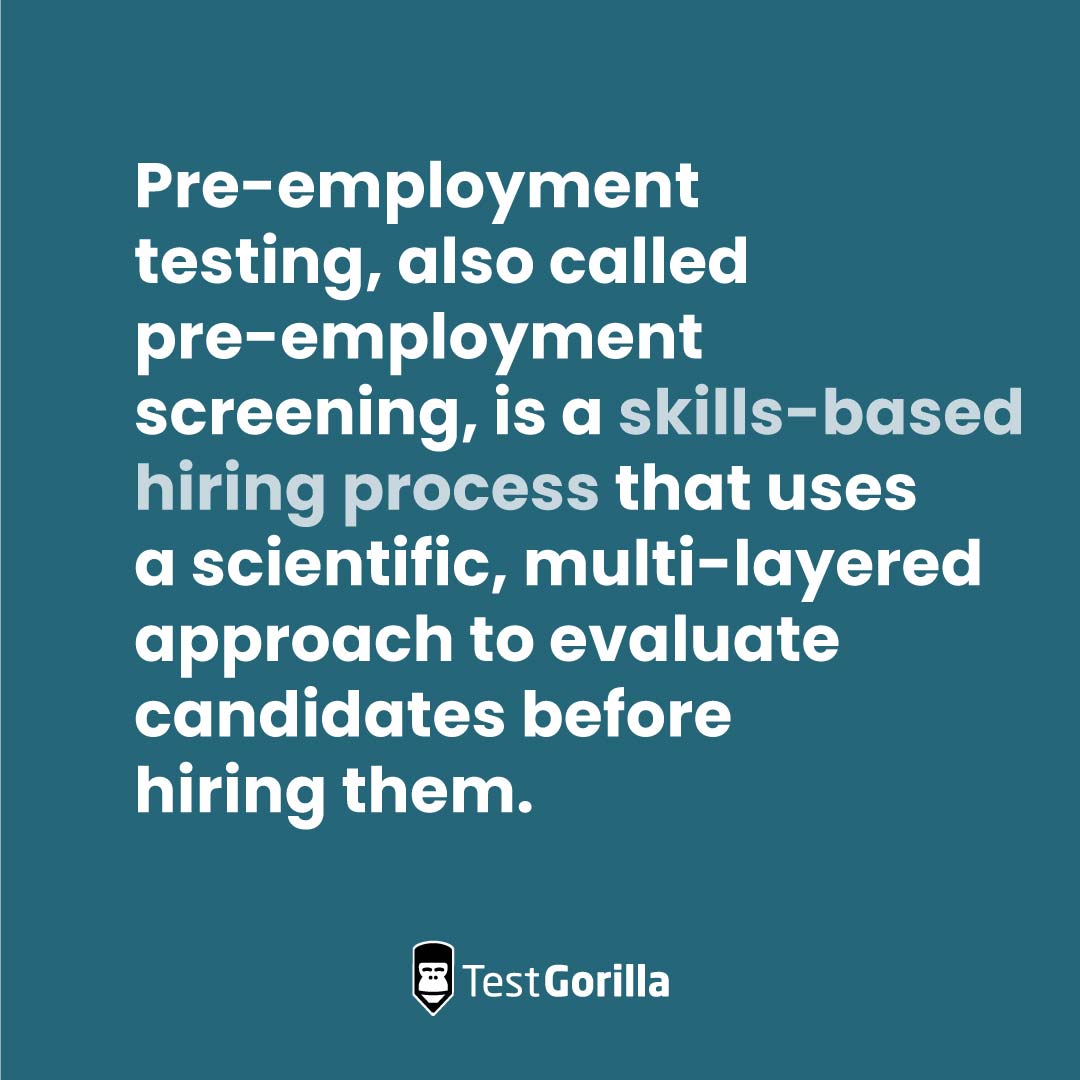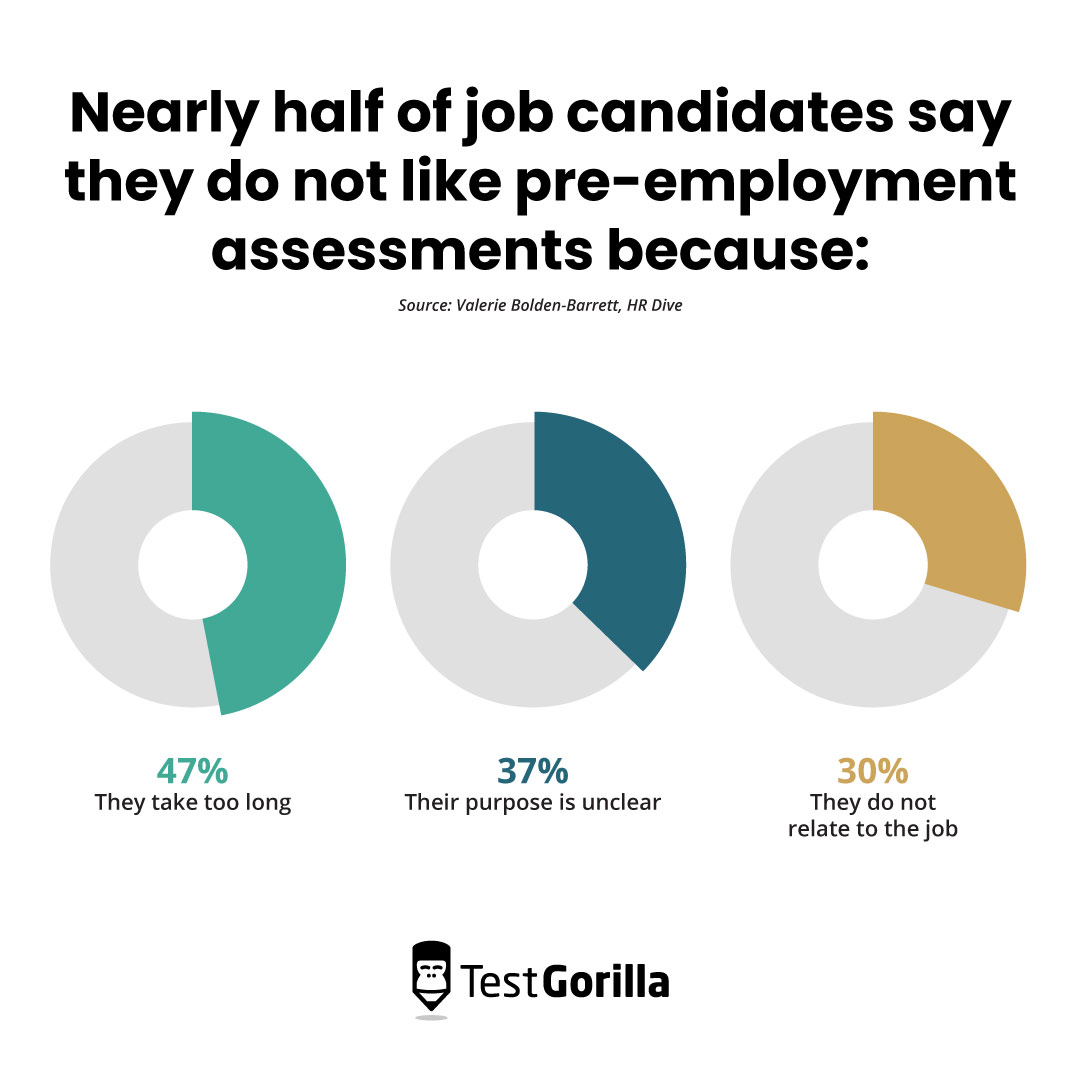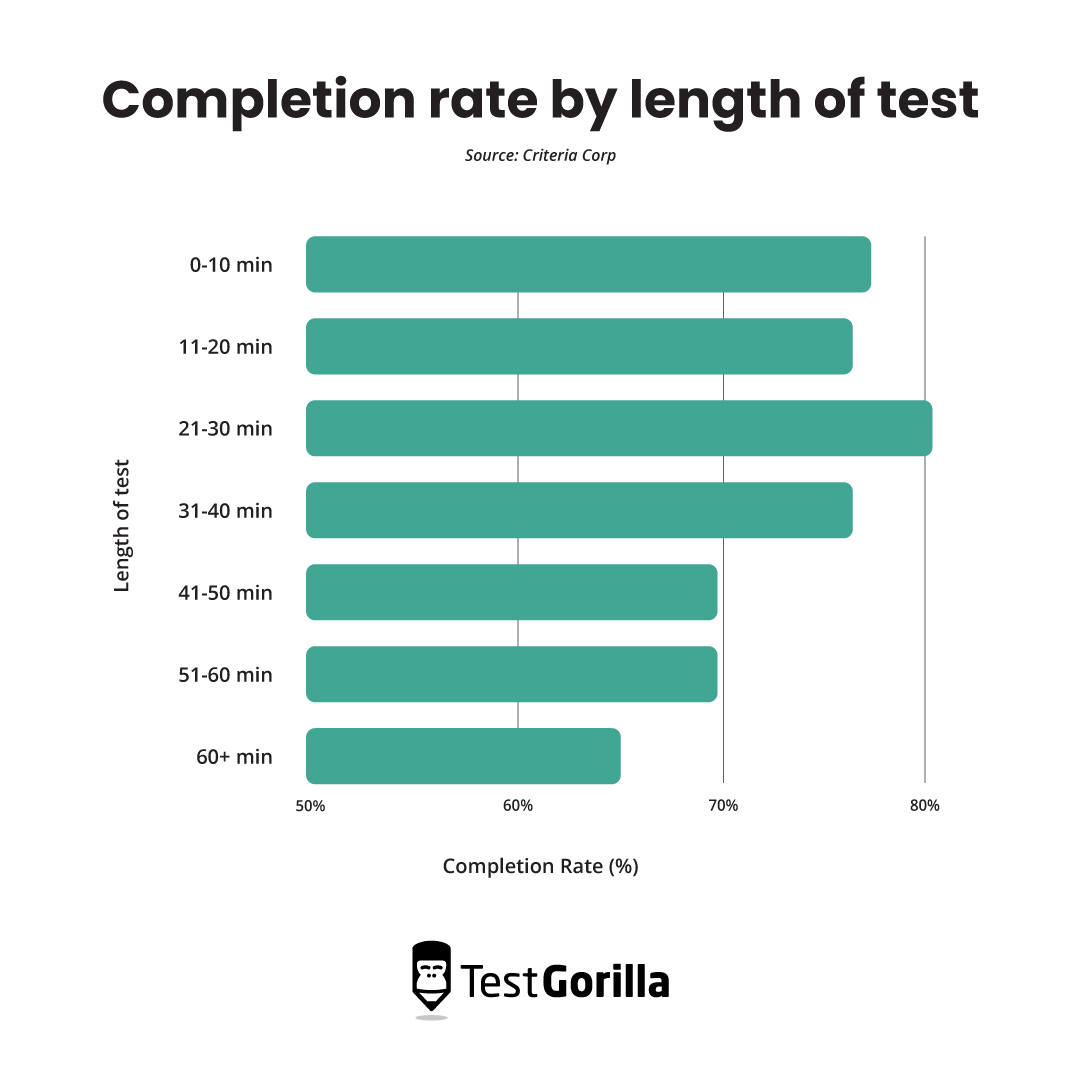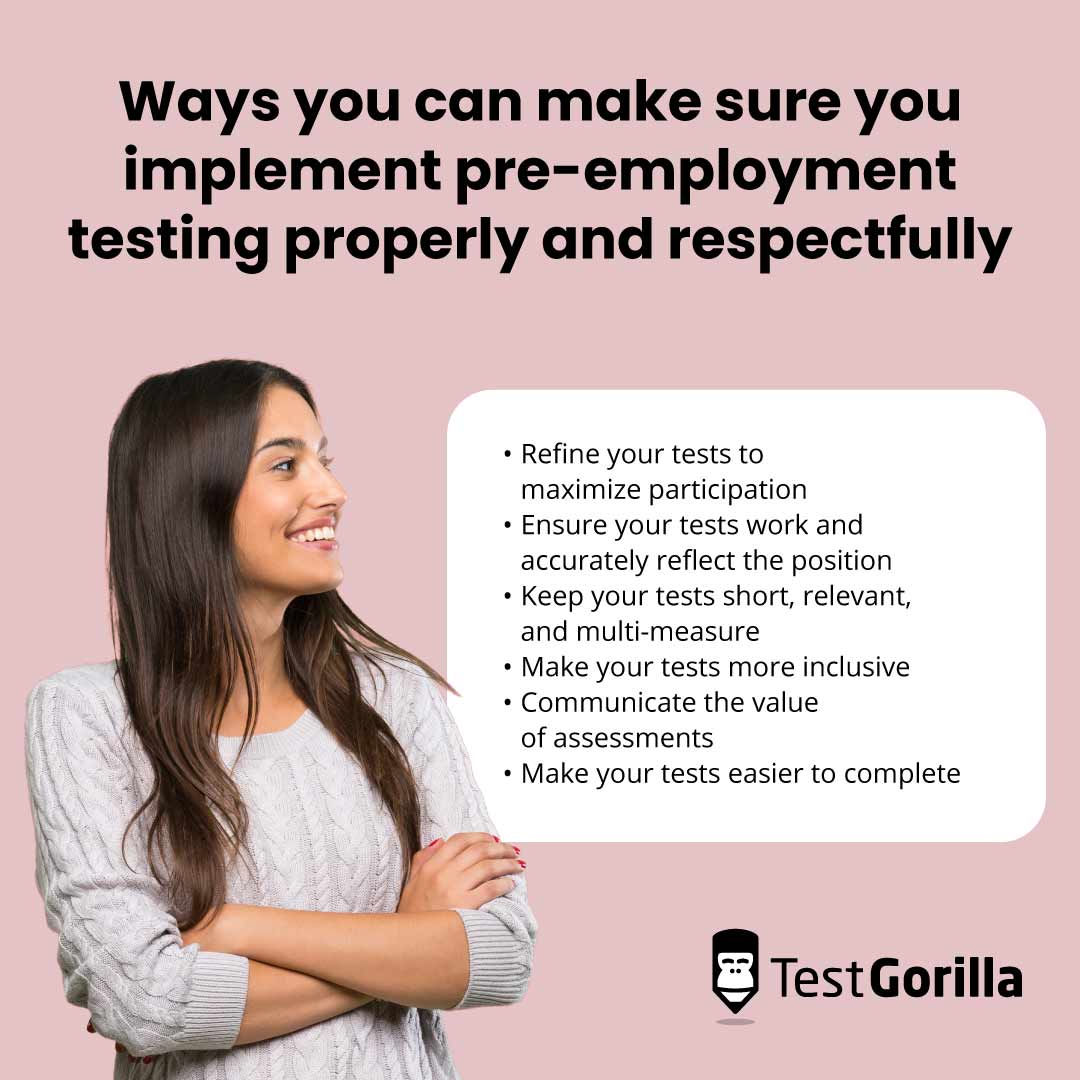Good candidates aren’t completing your assignments: Find out why
Pre-employment testing is a valuable tool that accurately predicts a candidate’s job performance.
Unfortunately, some candidates don’t like it. That doesn’t mean your job applicants are lazy or have commitment issues.
Using time-consuming pre-employment assessments that are not carefully crafted, inclusive, or relevant to the job does not respect the candidates’ feelings or time.
This also robs them of the chance to show their skills, which is the main reason for using skills assessments.
Do you want candidates to start completing your assessments?
Enlist an expert to create a test that reflects the job you are hiring for and isn’t unreasonably long.
If you make these changes to your pre-employment assessments, not only will candidates complete them, but they’ll also be grateful for the opportunity.
Table of contents
What is pre-employment testing?
Before diving into the best practices for pre-employment testing, let’s explore what that term means.
Pre-employment testing, also called pre-employment screening, is a skills-based hiring process that uses a scientific, multi-layered approach to evaluate candidates before hiring them.
Pre-employment testing comprises:
Skills assessments
Personality and culture tests
Role-specific tests
These tests offer employers different ways to determine a candidate’s suitability for a particular role.
A skills-based hiring approach uses a combination of assessments and structured interviews, rather than relying on a single metric to decide who to hire.
Why do good candidates hesitate to complete them?
Job candidates are diverse human beings with emotions, busy schedules, and skills.
Asking them to complete any work before hiring or speaking with them can come off as inconsiderate or unreasonable.
For example, making candidates complete basic math or language tests while requiring four-year degrees can insult their intelligence.[1]
What was the point of getting a degree if they still have to prove they can add, subtract, and write coherent sentences?
Research shows that nearly half of job candidates say they do not like pre-employment assessments because:
They take too long (47%)
Their purpose is unclear (37%)
They do not relate to the job (30%)
Some other reasons why candidates hesitate to complete pre-employment assessments are:
They cause anxiety. Anxiety can come from not being a good test taker, feeling blindsided by having to prove skills, or fearing a lack of bandwidth to complete a test for each job application.
They give a negative impression. Tests that are difficult to complete suggest that the employer’s time is more valuable than the candidate’s.
They don’t honestly evaluate skills. Pre-employment testing that claims to evaluate skills but is assessing personality or filtering candidates based on the hiring manager’s personal preference is dishonest and a red flag for many applicants.
They reduce candidates to a number. Pre-employment assessments that make candidates feel like a piece of data instead of enabling them to show off their skills are disappointing to many candidates.
They are biased. Bias can infiltrate every stage of the hiring process when companies use personality tests as evaluation tools instead of opportunities to learn more about the candidate as a person.
The best insights on HR and recruitment, delivered to your inbox.
Biweekly updates. No spam. Unsubscribe any time.
How can you help candidates complete your pre-employment tests?
If several candidates are opting out of pre-employment assessments, it doesn’t mean that all pre-employment assessments are bad.
The right combination of personality and skills tests accurately predicts job performance.
The key is making sure your pre-employment testing is implemented properly and respectfully by:
Refining your tests to maximize participation
Ensuring your tests work and accurately reflect the position
Keeping tests short, relevant, and multi-measure
Making your tests more inclusive
Communicating the value of assessments
Making your tests easier to complete
Getting candidates to complete your assessments isn’t just about their relationship to commitment – it’s about effectively communicating that you are willing to dedicate your time to give them the best opportunity to quickly and efficiently prove they deserve the job.
As an employer, you should avoid thinking: If my candidates cared enough or were hard-working enough, they would finish the whole test. The issue is more complicated than a candidate’s work ethic.
What was it like for you when you were looking for a job?
Maybe you were hard-working and committed, but you didn’t have an hour to take an unpaid test for an employer you knew nothing about.
Put yourself in the candidate’s shoes. What feels fair to ask of someone who may have skills and initiative but is in the middle of an intensive job search? Maybe candidates would enjoy showing their skills if the opportunity was more convenient.
Candidates approve of assessments as long as they reflect what to expect if they get the job and make reasonable demands of their time and effort.[2]
1. Refine your tests to maximize participation
The key is to have tests prepared by people skilled at writing tests rather than hiring managers or employers who know what they want to test for but not the right questions to ask.
Learn more about how to optimize your pre-employment assessments with our guide to pre-employment skills testing.
When you decide to use pre-employment assessments, the first and most important step is to ensure you choose the right platform.
Pre-employment testing software is prevalent, so you can identify your needs and your budget before making a decision.
Whatever you do, don’t rely on an untrained hiring manager or your intuition to create your pre-employment assessments.
Here are some questions to ask yourself when using pre-employment assessments:
Question | Why it’s important |
Which openings are you filling regularly? | Conduct a to identify the skills your candidates need to perform their roles. Without this process, you can make the wrong hire. |
Which tests do you need? | Hiring for technical skills like coding or design? Or soft skills like communication and critical thinking? Choose a platform that offers a range of tests that fit your needs. |
Are you concerned about cheating? | Always communicate when an assessment is a test or a tool to understand your talent pool so candidates don’t feel the pressure to cheat. Just in case, implement to protect your process. |
What are the pricing options? | Research what each company charges and how. Is it per candidate, per test, or a flat fee? Research ensures you budget effectively and secure the best assessments. |
Do you need to integrate your tests with an applicant tracking system (ATS)? | Decide how you are managing and implementing your assessments to keep your flow organized for yourself and your candidates. |
2. Ensure your tests work and accurately reflect the position
Before testing your assessments, it’s important to know what makes a test reliable.[3]
An employment test is considered good if it meets these standards:
Test standard | Why it matters |
The test measures what it says it measures | If a test claims to measure personality but tests technical skills, it misleads candidates and gives inaccurate data. |
The test measures what it claims to measure consistently | If a person retakes the test, they will get the same results, giving employers reliable data. |
The test is relevant to the job | It measures one or more characteristics important to perform well in the role, keeping candidates informed and results accurate. |
Results lead to effective employment decisions | The results should inform employers about which candidate to choose. If your tests do not pinpoint the best candidate, they don’t work. |
Make sure your tests have criterion validity, or in other words, the ability to be tested accurately against an existing gold standard.[4]
You can start by having your employees try out your assessments.
If your top employees perform well, your average employees perform fine, and your below-average workers perform poorly, you have an accurate assessment.
A crucial part of the pre-employment assessment process is strong workplace communication with your existing employees.
Including your employees in the hiring process by having them try out your tests and offer feedback makes them feel more included in organizational decision-making, which improves the accuracy of your tests and boosts employee morale.
You can get employee feedback by asking:
How did you feel when taking this test?
Were the instructions and questions clear?
Do you think this test accurately reflects your current work responsibilities?
Was the value of this test effectively communicated to you?
3. Keep tests short, relevant, and multi-measure
Keeping your tests short is crucial to getting them completed.
Besides showing your candidates that you respect their time, you can also grade tests quicker, saving time and money and increasing efficiency.
Aim to keep your tests shorter than 40 minutes because they have higher completion rates.[5]
Tracking your completion rates optimizes your testing process and keeps your tests relevant. If employees are skipping a question, chances are that question is unnecessary or unclear.
Improving the candidate experience gives applicants insight into your business and enables them to connect positively to the work before joining your team.
Just because your tests are short doesn’t mean your results should be. Make sure your tests are multi-measure to gain important data about a candidate’s technical skills, soft skills, situational awareness, and personality attributes.
Multi-measure testing gives employers a fuller picture of whom they’re hiring without exhausting candidates.
Using longer, less relevant tests can make candidates unhappy with your company and with testing in general. Unhappy candidates do not bode well for your future hiring process, as the Reddit user below eloquently explains:
4. Make your tests more inclusive
Research shows that pre-employment tests can end up increasing bias.
Personality testing that screens for desirable personality traits can introduce bias into your hiring practices if it is the sole assessment or primary decision-making tool. In other words, personality isn’t everything.
Take Julie Kae, the vice president of sustainability and DEI at Qlik. She says that most of her colleagues think she’s an extrovert when she’s not.
She adds that if she had received a personality test, she probably would not have gotten the job because she would have scored too low in that category.
A personality test couldn’t account for the time and resources she invested in coaching and practicing her public speaking and communication skills.
That’s why implementing a skills-based hiring approach with multi-measure assessments is so important. It enables you to easily locate and evaluate top-tier talent like Julie (who you may not have thought would be a great fit at first) without wasting time and resources.
A successful pre-employment testing strategy should always account for cultural diversity and culture add.
Testing for skills eliminates traditional hiring metrics like degrees, resumes, cover letters, and unstructured interviews that only serve to reinforce unconscious bias rather than combat it.
It is also important to implement pre-employment assessments that account for neurodiversity.
Being inclusive of neurodiverse candidates, who make up an estimated 15-20% of the population, is not just a respectful thing to do. It’s a smart business decision.
Neurodiversity refers to the diversity of all people. Many people use it in the context of autism spectrum disorder, however.
Many neurodivergent people bring great value to creative workplaces, where they thrive in roles that require:
Attention to detail
Focus and persistence
Flexibility
Creative thinking
Designing for neurodiversity keeps your hiring process unbiased by using a combination of pre-employment assessments for hard and soft skills, situational awareness and judgment, and behavioral interviews.
All these metrics should contribute to evaluating a candidate’s performance instead of personality alone.
5. Communicate the value of assessments
Maybe it seems like an obvious question, but why should candidates complete your assessments?
What value have you assigned to the process?
Is it just an excuse to judge a candidate’s pop culture knowledge, like in this candidate’s experience?
It’s easy to see why these particular tests turned this person off. Spending more than an hour on a test is way too long, and unless this person is applying to be a pop-culture writer, these tests are irrelevant.
Instead of trying to impress your candidates with questions you think are fun, impress them with all of the data-backed benefits of your multi-measure assessments.
Make sure to communicate the following in your job posting before candidates apply:
Your multi-measure tests ensure that no bias enters the hiring process. We have research to back it up: 91.1% of organizations saw an increase in diversity when using skills-based hiring methods. This benefits the organization and the candidate.
Your assessments do not take long to complete. If a candidate has the right skills, they should have no problem completing your assessment quickly. Encourage candidates not to spend more than 30 minutes taking a test.
Your assessments reflect on-the-job scenarios. Communicate this when the candidate has applied, and you send them the test or job simulation. The candidate needs to know that the work you are asking them to do is relevant to the actual job if they get hired.
Not all assessments are tests. Communicate this to your candidates early. It’s not about getting the right answer all the time. It’s giving them the freedom to express themselves in a safe environment. Emphasize this point in your job posting and within the tests themselves.
They shave time off the process. If applicable, let your candidates know that your tests eliminate other time-consuming hiring processes like resume screening and unstructured interviews.
6. Make your tests easier to complete
To clarify, the tests shouldn’t have easy answers for the sake of getting them completed.
You also shouldn’t ask questions that have a preferred answer, like the one this candidate encountered:
On the other hand, your tests should not be so unnecessarily complex to eliminate qualified candidates who can’t grasp what the test asks.
It’s important to keep in mind:
Why you are testing: To eliminate unqualified candidates and get a better understanding of top candidates’ skills, not to trick candidates or get them to say what you want to hear.
Who you are testing: Your employees may feel more comfortable taking a test because they are in a familiar setting with resources available (like in the workplace). New candidates may not know much about your organization and may experience tests as stressful or intimidating.
How you are testing: If your employees find it difficult to navigate your assessment tools, your candidates will, too.
If you are hiring a graphic designer, for example, you can use an Adobe Photoshop test to evaluate:
How the candidate navigates the software
If they understand key concepts
If they can edit and manipulate photos
If they can work with selections, masks, and channels
You can also offer a job trial where the candidate must complete a paid assignment, like an email header.
It’s a delicate balance, but give the candidate enough time to complete the assessment, along with references, images, and resources to pull from.
Paid job trials show the client you’re willing to put some skin in the game by paying them and showing them what type of work to expect if they get the job.
Use skills-based hiring best practices to get your assessments completed
Pre-employment assessments can catch a lot of heat from job seekers who feel that you’re not respecting or taking into account their time, intelligence, feelings, and skills.
Yet assessments are great tools to locate skilled candidates quickly and efficiently, and are great predictors of job success. Like any tool, they must be built correctly and used properly to be effective.
Skills-based hiring implements multi-measure assessments created by experts and driven by data.
They are considerate of time and usability, and protect against bias.
Following pre-employment assessment best practices increases your completion rate and improves the candidates’ experience.
With pre-employment assessments, communication is key. Learn more about how to invite, remind, delete, or check the status of your candidates with our Managing candidates guide to keep communication flowing.
With role-specific skills tests, everyone is in the loop and able to benefit from an effective hiring process.
Sources
Martin, Dan. (March 6, 2023). “Pre-Employment Assessments Have To Stop”. Dan’s Growth Newsletter. Retrieved April 20, 2023. https://www.dansgrowthnewsletter.com/p/pre-employment-assessments-have-to
Newsdesk. (April 29, 2019). “Candidates don’t hate pre-hire assessments; they just had bad ones”. The Global Recruiter. Retrieved April 20, 2023. https://www.theglobalrecruiter.com/candidates-dont-hate-pre-hire-assessments-they-just-hate-bad-ones/
U.S. Department of Labor Employment and Training Administration. (1999). “Testing and Assessment: An Employer’s Guide to Good Practices”. HR-guide.com. Retrieved April 25, 2023. https://hr-guide.com/Testing\_and\_Assessment/Reliability\_and\_Validity.htm
Bellamy, Nicholas. (2015). “Principles of clinical outcome assessment”. Rheumatology (Sixth Edition). Retrieved April 20, 2023.
“Best Practices for Implementing Pre-Employment Testing”. (n.d.). Criteria. Retrieved April 20, 2023.
You've scrolled this far
Why not try TestGorilla for free, and see what happens when you put skills first.


















